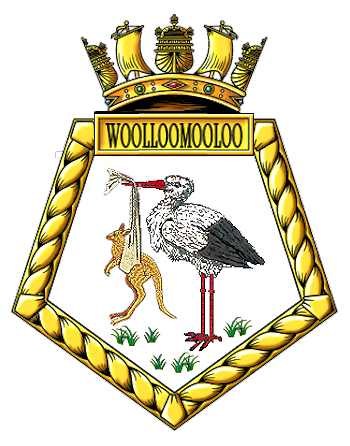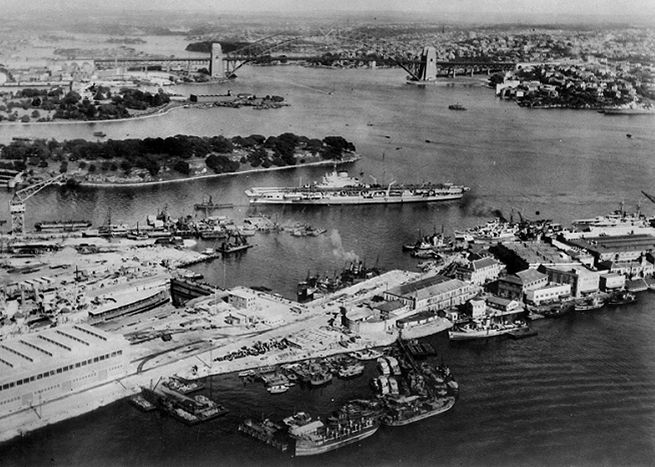X
Extract from the reminiscences of Stoker first class James Fee
Jimmy was drafted to HMS GOLDEN HIND II the Fleet Repair Base at Garden Island, Sydney, Australia. He travelled out on the troopship NEIUW AMSTERDAM sailing from Greenock, Scotland on April 22nd, he returned home on MAS PATROLLER arriving back in the UK on April 19th 1946.
Off to Australia
One Sunday morning at six o clock we were put on a train in Chatham dockyard. thirty hours later we were in Greenock, Scotland. We were taken by ferry to a ship called NEIUW AMSTERDAM, a Dutch liner, we were locked in a room about two hundred of us. The next day having had nothing to eat we complained to an American marine captain who thought we were prisoners, he arranged for us to have a feed in a mess hall down below. He asked me to find some men like myself to volunteer as gun crew and we would have the run of the ship and a cabin for nine of us with a shower. That is how I became a gunner on Oerlikon number one on the port side up forward wearing a big badge with’ gun crew’ written on it which entitled us to go anywhere on the ship. One night on watch at two o clock in the morning I heard the war was over in Dutch by our Dutch captain. then an English voice told us the war was over in Europe, we were in the middle of the Indian ocean at the time. So, we the gun crew spliced the main brace on the king’s orders with white rum. I lit a cigarette and was told to put it out as we were still at war with Japan.
Our orders were to fire first unless told otherwise; one day a sub surfaced, the American gunners opened fire and put a shell thru its bows. we were told cease fire and a white flag was raised we thought we had captured a jap sub but it turned out to be American. They asked us to tow them but we did not stop as we were loaded with troops. Next day we arrived at Freemantle and were marched ashore to a big field where we were given cakes and tea. An officer gathered us all together and said the ausies were disappointed at the way we had strolled through the town and asked us to put on a show of real good marching back to the ship. we did as he asked us and the people of Freemantle cheered us all the way back to the ship shouting, we are proud of you. As we left port the next day the American sub came limping in and the American gunners on our ship jeered at them for being so stupid for not signalling us that they were going to surface
Life in Sydney
We arrived in Sydney and a Chief Petty Officer lined about a hundred of us up and asked if there were any lorry drivers among us, nobody moved. He said I am going to read some names out. he read three names and mine was one of them. I said “I am not a lorry driver.” He said “you drove an ambulance in the civil defence”. How he knew that I will never know. I also entertained the troops while working in the shipyard, I said “why don’t you put me down for ENSA”. He pointed across the water to three lorries parked on the dock, then gave us a map of Sydney and told us to go to Warwick Farm Racecourse which was HMS GOLDEN HIND and bring all hammocks and kitbags with red bands on them back to Woolloomooloo, and do not look for your own first which is exactly what I did.
We lived and slept in the dock sheds at Woolloomooloo for six months. then we were moved to the Domain and army huts, it was called HMS ALERT, the commander was T.E. Robertson the brother of Anna Neagle who later became Dame Anna Neagle the stage and film star. He was a real gentleman and thought the world of Geordies. I became his driver as well as driving the lorry. I once had to fetch him back from a cocktail party, he offered me a cocktail and I had one too many. When we got to the car I said “I am too drunk to drive” and handed him the keys and he drove us back. I had my twenty first birthday on august the ninth 1945 the day that the second atomic bomb was dropped on Nagasaki, the skipper gave me five pounds and my Australian friends give me the first birthday party I had ever had. They were Mr and Mrs Flemming of 16 Jellicoe Ave, Randwick, Sydney and gave me the champagne they were keeping for their daughter Beryl when she was twenty-one.
The day of Japan’s surrender I went into Sydney and all the people were dancing round me. I met up with an aussie airman and two girls who lived in north Sydney so we walked over the harbour bridge to the girls home where we had tea, I did not have a drink of anything stronger that day.
Coming home
I sailed home in 1946 on an aircraft carrier the HMS PATROLLER. I was made the ships welder. I was over the side in the Indian ocean in a bosun’s chair and a bowline round me when the chap who was holding the rope said I see it is still there, I looked down and I was resting my feet on a hammer head shark about thirty foot long .It was more like a whale. I had been over the side for three days and he never told me! He said “I thought you knew. I was telling all my mates what a brave bloke you were.” The skipper sent for three rifles and said “on the count of three fire” and it just slowly swam away.
when we arrived in England at seven o clock on Good Friday morning it was cold and foggy.
Jimmy Fee
Original source: www.freewebs.com/jimmyfee/stories.htm - now defunked. Material later submitted to BBC people’s war project.



Comments (1)